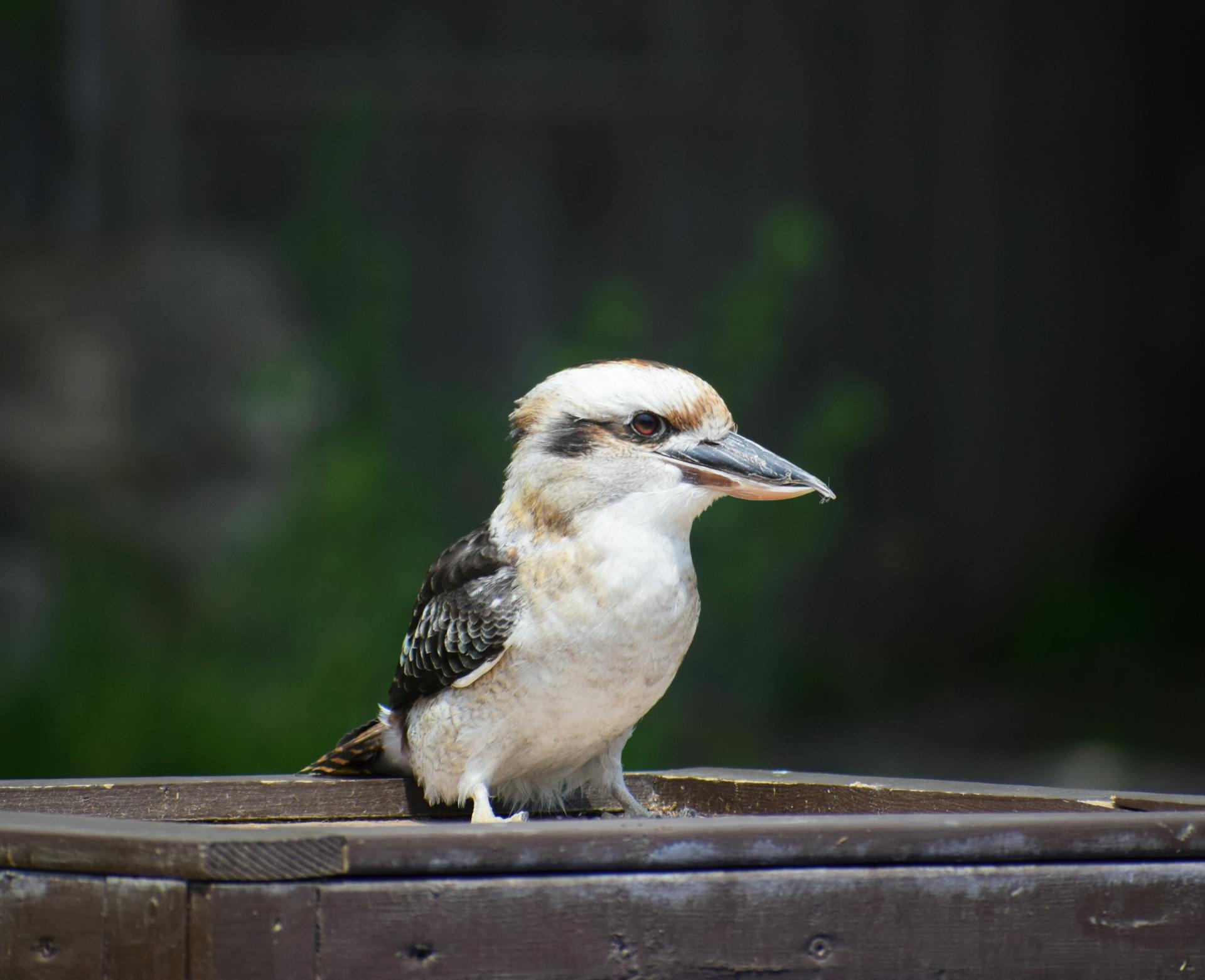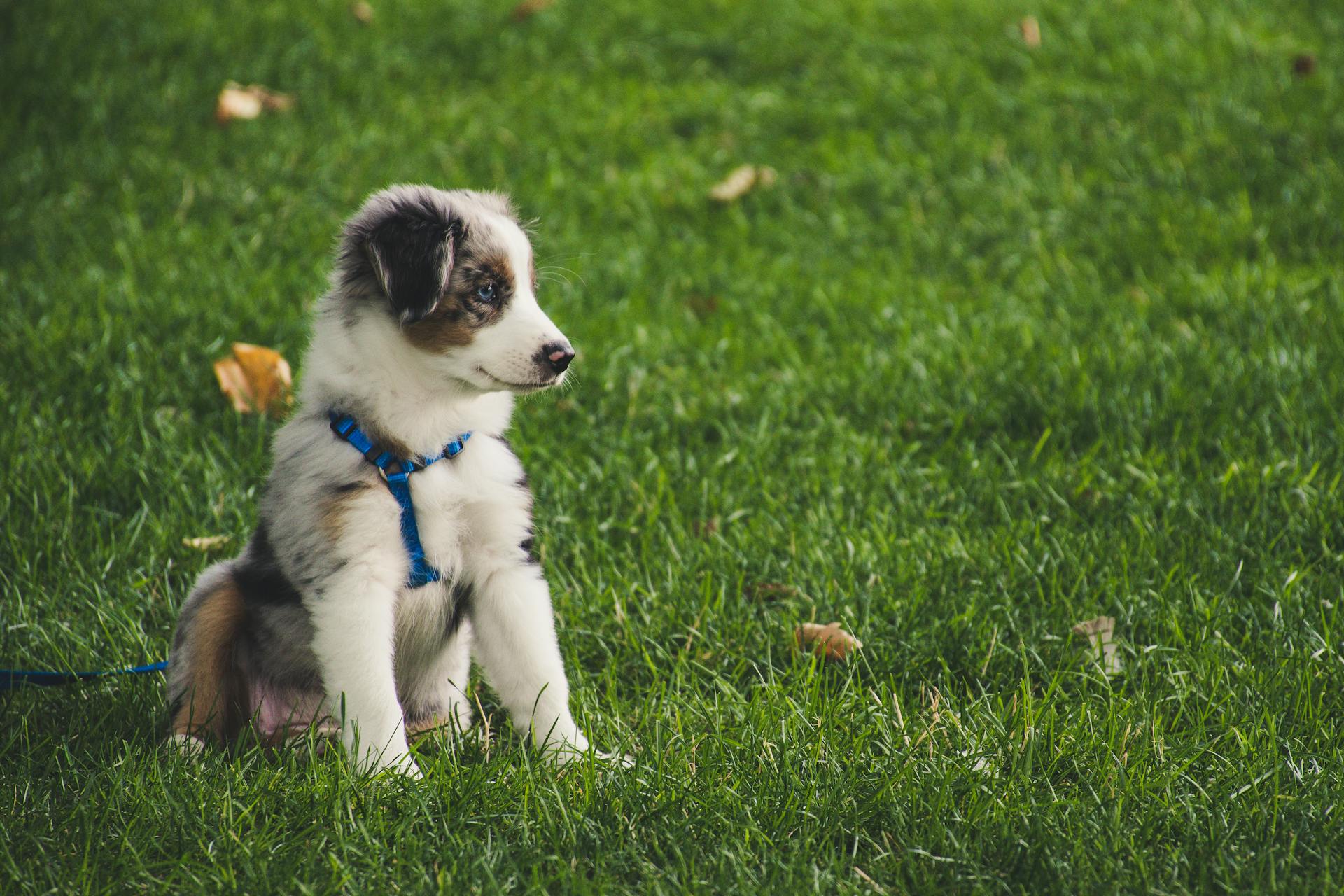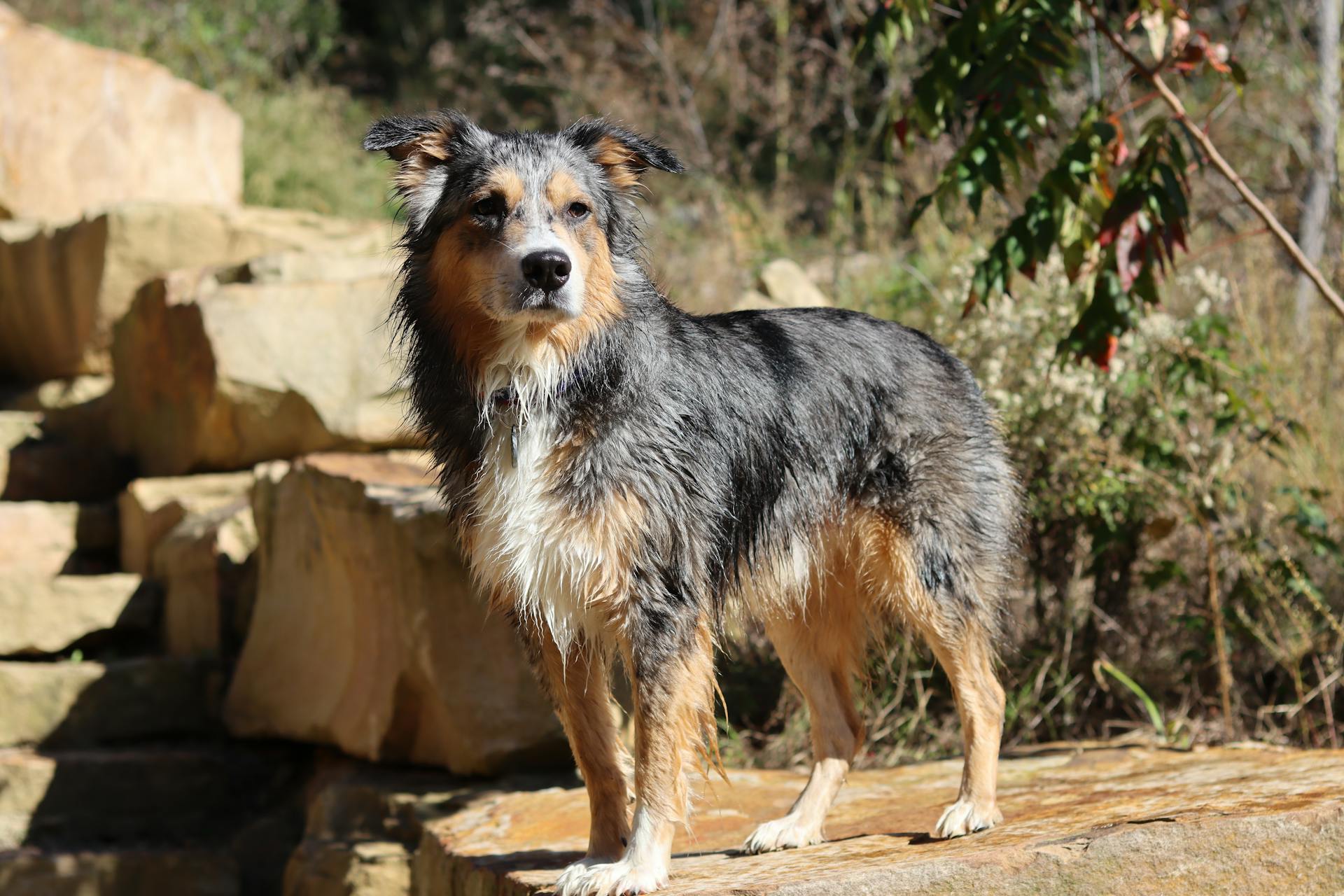
The Australian Shepherd Husky Mix is a unique and fascinating breed that's gaining popularity worldwide. This crossbreed combines the intelligence and agility of the Australian Shepherd with the endurance and loyalty of the Siberian Husky.
They typically weigh between 35-60 pounds and stand between 18-23 inches tall at the shoulder. Their coat can vary in length and texture, often requiring regular grooming to prevent matting and tangling.
Their high energy levels mean they need plenty of exercise to stay happy and healthy, making them a great fit for active families or individuals who enjoy outdoor activities. With proper training and socialization, they can thrive in a variety of living situations.
What Does It Look Like?
The Australian Shepherd Husky mix is a visually appealing dog, but its physical characteristics can vary depending on the genes it inherits from its parents.
They usually stand at about 20 to 24 inches in height, with males slightly larger than females.
Their coat is a thick, double coat that can range from medium to long, similar to the Australian Shepherd.
Their coat colors are varied, often displaying a mix of black, white, gray, brown, and the distinctive blue merle pattern of the Australian Shepherd.
They may inherit the Husky's striking blue eyes or have heterochromia (two different colored eyes).
Their ears can be upright like the Husky's or slightly floppy like the Australian Shepherd's.
In build, they tend to be muscular and agile, reflecting their high energy levels and active nature.
The Aussie Husky can inherit genes from either parent, and this can either be more dominant from one parent or a combination of both parents.
Their weight usually lingers anywhere between 40 to 55 pounds for the average male and 35 to 55 pounds for the average female.
They have a dense, weather-resistant double-coat and come in a variety of base colors, from black, brown, cream, gray, and white and in different combinations of shades and patches.
One color will usually dominate the chest to belly area and the legs and paws, while another color will dominate the rest of the body.
Their facial features include triangular shaped ears and oval eyes that can be in various colors.
Intriguing read: Are Aussies Double Coated
Temperament and Personality
The Australian Shepherd Husky mix is a dynamic, intelligent, and affectionate breed that requires an owner who can provide ample exercise, mental stimulation, and love.
They are known for their high energy levels and strong desire for activity, making them excellent companions for active individuals or families.
Their intelligence is a trait passed down from both parent breeds, making them quick learners and responsive to training.
However, their intelligence also means they require mental stimulation to prevent boredom, which can lead to destructive behavior.
Engaging them in training, puzzle games, and regular playtime is essential for their mental well-being.
The Aussie Husky enjoys being around people and is known for its affectionate nature, thriving on interaction and forming strong bonds with family members.
Early socialization is crucial to ensure they are well-adjusted and comfortable in various situations.
They are generally good with children and other pets, primarily when raised with them, but supervision is always recommended due to their size and energy.
You might enjoy: Are Border Collies Affectionate
Their independence can sometimes lead to protective instincts, making them alert and attentive companions.
They require an owner who can provide regular exercise, as lack of adequate exercise can lead to frustration and behavioral issues.
In return for proper care, they offer unwavering companionship, making them an excellent addition to an active household.
Their high prey drive means they will chase small animals if not properly trained, making leash training essential.
They can also be great alert dogs, letting their owners know if a stranger approaches or if there's a potential threat.
However, they may not be the best fit for apartment living due to their high energy levels and need for space to roam.
For your interest: Are Border Collies High Energy
Lifespan and Wellness
The Australian Shepherd Husky mix generally lives for 12 to 15 years, depending on genetics, diet, exercise, and overall care. This breed typically enjoys a robust and healthy life, but attention to their specific health needs and regular veterinary care can make a significant difference.
Here's an interesting read: Bernese Mountain Dog Care
Regular exercise is crucial for their physical and mental health, as they have high energy levels. A well-balanced diet tailored to their age, size, and activity level is also essential, and consulting with a veterinarian to create an appropriate feeding plan is advisable.
Maintaining routine veterinary check-ups, vaccinations, and parasite prevention is critical to maintaining their health. This includes dental care and grooming to prevent secondary health issues.
Australian Shepherd Huskies can inherit sensitivities to certain foods or environmental allergens, leading to skin irritation and other symptoms. Regular eye exams are also essential to catch any eye problems early, such as cataracts and progressive retinal atrophy.
Here are some common health issues to be aware of:
- Joint Issues: hip dysplasia and other joint problems
- Eye Problems: cataracts, progressive retinal atrophy, and other eye issues
- Epilepsy: a predisposition to seizures
- Allergies and Skin Conditions: sensitivities to foods or environmental allergens
Preventing these health issues requires proactive care, including regular veterinary check-ups and a balanced diet. Mental stimulation through training, play, and interaction can also prevent boredom and associated stress or anxiety.
Health Issues
The Australian Shepherd Husky mix is a crossbreed that can be prone to certain health issues, just like its parent breeds. Regular check-ups and proper care can help manage these risks.
Joint issues, such as hip dysplasia, are common in both Australian Shepherds and Siberian Huskies. This can lead to arthritis and mobility problems if left untreated.
Eye problems, including cataracts and progressive retinal atrophy, are also common in both parent breeds. Regular eye exams are essential to catch any problems early.
Some other health issues that may affect the Australian Shepherd Husky mix include epilepsy, allergies, and skin conditions. These can be inherited from the parent breeds or caused by environmental factors.
Here are some specific health issues that may affect the Australian Shepherd Husky mix:
- Allergies
- Anxiety
- Corneal Dystrophy
- Ear Problems
- Elbow Dysplasia
- Epilepsy
- Eye Anomaly
- Hip Dysplasia
- Progressive Retinal Atrophy
Maintaining a healthy weight is crucial for your Australian Shepherd Husky mix's longevity and general well-being. Regular exercise and a balanced diet can help prevent weight gain and reduce the risk of health problems.
Care and Maintenance
This Australian Shepherd Husky mix requires regular grooming, so be prepared to brush their thick, double-layered coat 2-3 times a week and daily during shedding seasons.
They are moderate to heavy shedders, especially in spring and fall, so using a de-shedding tool or undercoat rake can be particularly effective.
Bathing should be done once every 2-3 months, or as needed, using a dog-specific shampoo that caters to their coat type.
Over-bathing can strip their natural oils, leading to dryness and irritation, so it's essential to find the right balance.
Nail trimming is crucial to prevent discomfort and potential health problems, and you'll know it's time when you hear their nails clicking on the floor.
Regular ear and dental care is also vital, including checking and cleaning their ears regularly and providing dental chews to prevent dental diseases.
A balanced diet is essential for their size, age, and activity level, so consult with a veterinarian for personalized dietary recommendations.
Regular veterinary check-ups are necessary to monitor their health and catch any issues early, and you can create a care regimen with your vet's assistance.
Australian Shepherd Huskies have a lot of energy, so regular physical activity is a must, and taking them to the dog park can be a great way to socialize and exercise them.
Related reading: Yorkshire Terrier Care
Their ears should be cleaned regularly without getting liquid inside the ear canal, and their eyes should be wiped as needed with a clean towel.
Cutting their nails once or twice a month can prevent them from getting too long, and you can get this done when you take them to the groomer.
This breed is not suitable for extremely hot weather due to their dense, double coats, so a cold climate with at least one season of cold weather is ideal.
Grooming Needs
The Australian Shepherd Husky mix has a double coat that sheds a lot, so be prepared to vacuum regularly.
They need thorough brushings daily, especially during shedding season, to prevent matting and tangling.
Using a regular slicker brush and an undercoat rake can be particularly effective in removing excess fur.
Bathing should be done only when necessary, using a light shampoo to prevent stripping the coat of its natural oils.
Daily brushing is also essential for their teeth, with a minimum of twice a week recommended for a healthy and shiny coat.
Their ears should be checked and cleaned regularly to prevent infections, and it's best to use natural products to avoid harsh chemicals.
Cutting their nails once or twice a month can prevent discomfort and potential health problems.
Their double coat requires regular grooming, but it's worth it for their beautiful and healthy appearance.
Family and Lifestyle
Australian Shepherd Husky mixes make fantastic family pets for active families who can provide the right environment. They thrive in homes with ample space and plenty of opportunities for exercise and play.
Their high energy levels mean they're best suited for houses with yards, not small apartments. This is especially true if you have young children who can engage in active play with them.
If you live in an area with extremely hot weather, this breed may not be the best fit due to their thick double coats. They'll appreciate a climate with at least one season of cold weather to keep them comfortable.
With proper training and socialization, Australian Shepherd Husky mixes can become loyal and well-behaved companions.
Intriguing read: Names for Red Merle Australian Shepherd
Real Owner Experiences
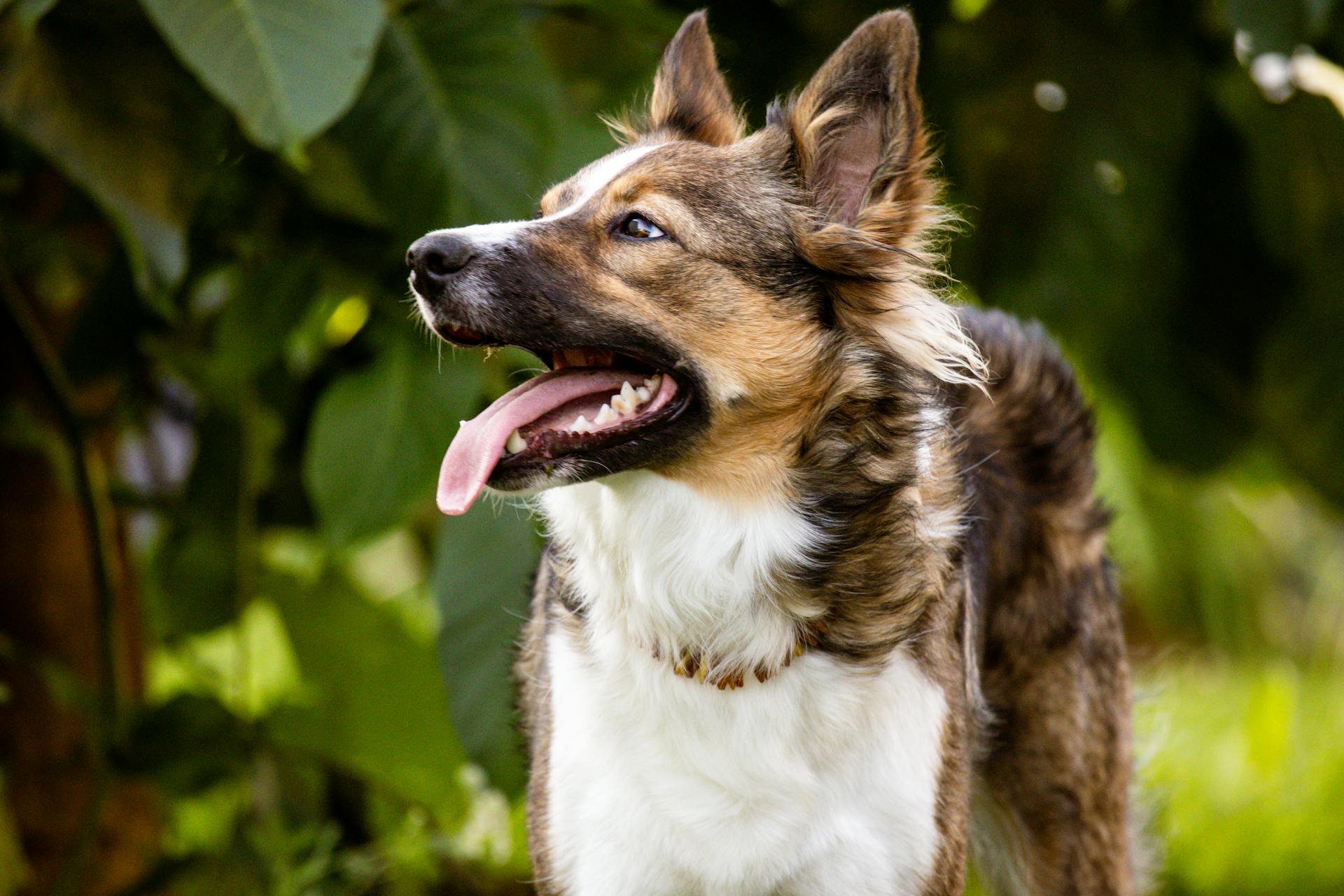
I've had the pleasure of meeting several owners of these dogs, and they've all mentioned how great they are at alerting them to potential threats. They're naturally protective of their families and will sound the alarm if they sense something's off.
One owner told me that their dog will chase after anything smaller than themselves if not properly trained, which is why leash training is a must. This means they'll happily chase after a tennis ball, but also potentially after squirrels or other small animals.
I've noticed that these dogs are happiest when they have a huge yard to explore and roam freely, making them a great fit for families with a big backyard. They'll be much more content and less likely to get into mischief if they have plenty of space to run around.
As one owner put it, training is key to making sure these dogs suit your needs and wishes. With proper training, they can be great guard dogs that will let you know if any stranger walks by.
Intriguing read: Can Shiba Inu Reach 1 Dollar
Living Conditions
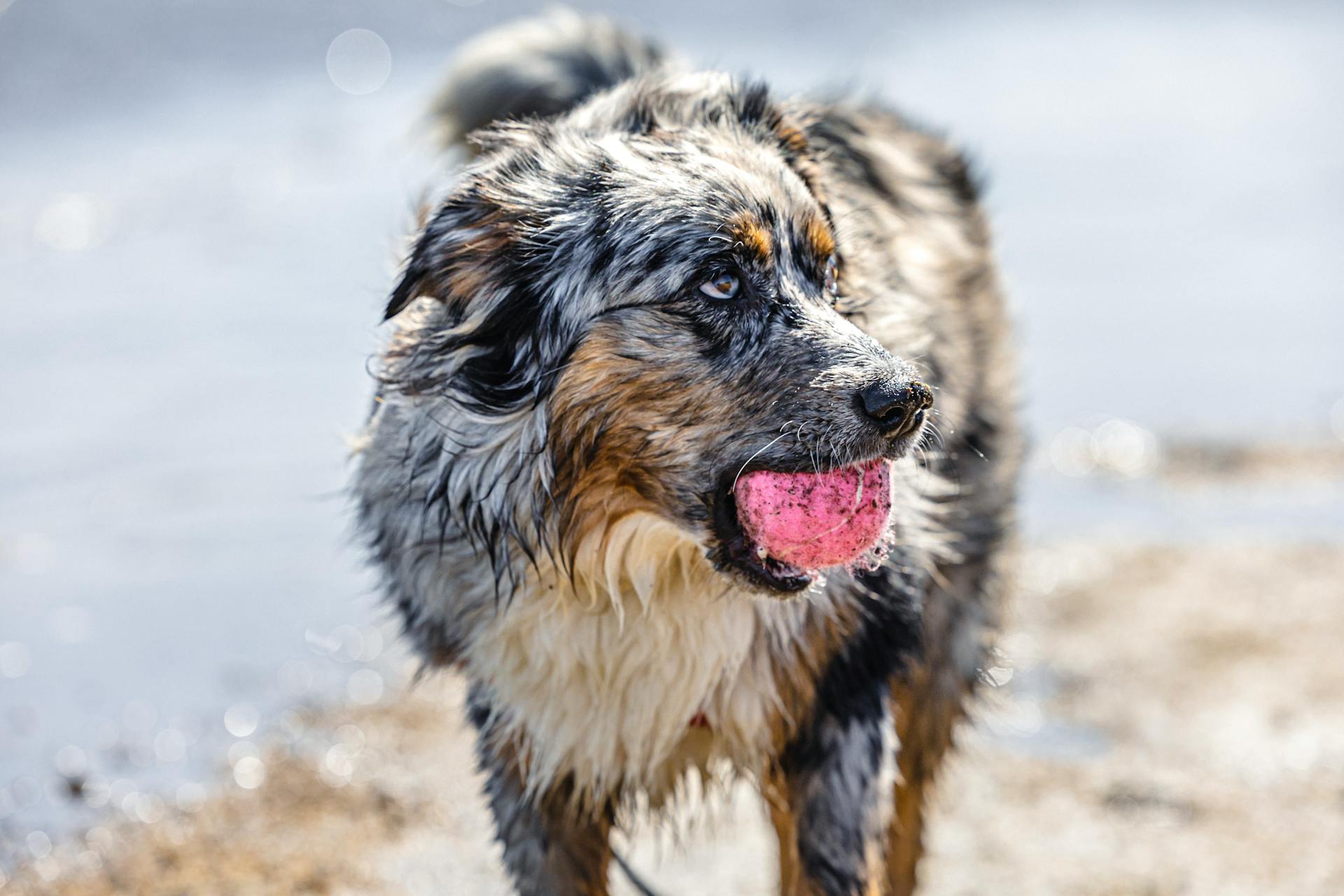
Australian Shepherd Husky mixes are highly energetic dogs that require a lot of space to run around. They thrive in environments with yards rather than small apartments.
Their herding instincts might prompt them to chase smaller animals, so it's essential to socialize them properly from an early age. This will help manage their tendencies and ensure they coexist harmoniously with other pets.
If you live in an extremely hot weather climate, this breed is not the right fit for you. Their dense, double coats will prevent them from living easily in such places.
A cold weather climate with at least one season of cold is the best for Australian Shepherd Husky mixes. This will keep them comfortable and happy.
To keep your Aussie Husky occupied and prevent destructive behavior, make sure to provide them with enough mental and physical stimulation. This can be achieved through activities like hiking, running, walking, and playing.
A secured and proper fence system is crucial if you have a backyard for your Aussie Husky to run around in. This will prevent them from exerting cooped-up energy by jumping over the fence.
A fresh viewpoint: How Fast Do Border Collies Run
Other Pets at Home
Having other pets at home can be a great addition to your family, but it's essential to consider the needs and personalities of your Australian Shepherd Husky Mix. Proper socialization is crucial at an early age for pups to display friendly behavior towards other pets.
It's not just about socialization, though - you also need to think about whether your other pets are energetic enough to keep up with your Aussie Husky. If your pets are too laid back, it may not be the best match.
An energetic, playful, and outgoing dog is the perfect match for an Aussie Husky in the same household. This will help your dog feel happy and fulfilled.
Broaden your view: Mini Aussie Shepherd
Adoption and Buying
Adopting an Australian Shepherd Husky mix can be a rewarding experience, and it's essential to ensure that you acquire your new companion responsibly.
Consider checking local shelters and rescue groups specializing in Australian Shepherds, Huskies, or mixed breeds. Adoption provides a loving home to a needy dog, often including initial health checks and vaccinations.
When adopting, inquire about the dog's history, temperament, and known health issues to ensure they fit your family well.
If you buy an Australian Shepherd Husky mix from a breeder, do thorough research to find a reputable one. A reputable breeder prioritizes the health and well-being of their dogs over profit.
Ask a potential breeder about the parents' health history and temperament. A reputable breeder should be knowledgeable and open about the breed and able to provide detailed information.
- Red Flags to Watch Out For
- Multiple litters available all year round
- Unwilling to show where the dogs are kept
- Don't ask you questions about your lifestyle or experience with dogs
Ensure the puppy or dog has undergone necessary health screenings, which is crucial given the potential health issues associated with the parent breeds.
Suggestion: Rhodesian Ridgeback Health Issues
Adoption and Buying
Adopting an Aussie Husky can be a rewarding experience. Consider checking local shelters and rescue groups specializing in Australian Shepherds, Huskies, or mixed breeds.
Adoption provides a loving home to a needy dog, often including initial health checks and vaccinations. You can also inquire about the dog's history, temperament, and known health issues to ensure they fit your family well.
A unique perspective: Pembroke Welsh Corgi Health Problems
If you're looking to adopt, make sure to ask about the dog's history and temperament. A reputable rescue group should be able to provide you with detailed information about the dog.
If you're buying an Aussie Husky from a breeder, do thorough research to find a reputable one. Ethical breeders prioritize the health and well-being of their dogs over profit.
A reputable breeder should be transparent about their breeding practices and provide health clearances for both parent breeds. They should also allow you to visit their facility.
- Ask the breeder about the parents' health history and temperament. A reputable breeder should be knowledgeable and open about the breed.
- Be wary of breeders who don't ask you questions about your lifestyle or experience with dogs.
It's essential to ensure the puppy or dog has undergone necessary health screenings, especially given the potential health issues associated with the parent breeds.
Curious to learn more? Check out: Pointer Dog Health Issues
Costs
The average price of an Australian Shepherd Husky Mix will range from $600 - $1,000.
You can expect to spend around $600-1,500 per year on veterinary costs, not including any health condition-specific medications or supplements.
Training classes may cost anywhere from $25 - $300 per year, depending on whether you choose books, classes, or a personal trainer.
Miscellaneous costs, such as toys, leashes, beds, food, treats, grooming, supplements, and vitamins, can add up quickly.
Additional reading: Can Shiba Inu Reach 1 Cent
Training and Behavior
Training an Australian Shepherd Husky mix requires patience and consistency due to their independent streak. They respond well to positive reinforcement methods, such as rewards and praise.
Their intelligence and desire to please make training an enjoyable experience, but early socialization and obedience training are crucial to develop a well-mannered dog. They thrive in activities that challenge their intelligence, like agility training and dog sports.
Lack of adequate exercise can lead to destructive behaviors, so they need at least an hour of vigorous exercise daily. This can include running, hiking, or playing fetch, and is well-suited for active owners who enjoy outdoor activities.
Related reading: How Much Exercise Do Border Collies Need
Training Needs
The Australian Shepherd Husky mix is a breed that combines the intelligence and eagerness of the Australian Shepherd with the Husky's independence and energy. This blend results in a dog that is both a joy and a challenge to train.
Positive reinforcement methods work best for training an Aussie Husky, as they respond well to rewards and praise. Early socialization and obedience training are crucial to develop a well-mannered dog.
They also thrive in activities that challenge their intelligence, like agility training, advanced obedience, and even dog sports. These activities help keep their minds active and engaged.
Lack of adequate exercise can lead to destructive behaviors, as they become bored quickly. Regular exercise, such as running, hiking, or playing fetch, is essential to keep them physically and mentally stimulated.
Interactive toys, puzzle games, and regular training sessions help provide mental stimulation for this mix. Teaching them new tricks or engaging in activities like scent work or hide-and-seek can be a great way to challenge their minds.
Establishing a routine for exercise and training sessions helps manage their energy levels and keep them mentally satisfied. Consistency in commands and expectations during training sessions is critical to effective learning.
Dogs with a Husky background, like the Australian Shepherd Husky mix, may require a little more patience and consistency in training due to their independent nature.
What Are You In For?
As you bring home your Australian Shepherd-Siberian Husky Mix, you're likely to be in for a treat. These dogs are known for being gorgeous, loving, and playful.
People often comment on the physical resemblance of the mix to its Husky parent, with many saying they see more Husky than Australian Shepherd. Emily Medrano, a commenter, mentioned that she definitely sees more Husky in the dog she's looking at, but still loves the mix.
You can expect a lot of energy from your Aussie Husky, as both parent breeds are known for being active and playful. Rae Mendoza, another commenter, simply calls the dog gorgeous, without mentioning its age or sex.
Training your Aussie Husky will require patience, consistency, and positive reinforcement. With the right approach, you can help your dog become a well-behaved and loving companion.
Related reading: Aussie Pom Dog
Nutrition and Wellness
The Australian Shepherd Husky mix is a robust and healthy breed, but they do have specific health needs that require attention.
Regular exercise is crucial for their physical health and mental well-being, and they need at least 1 hour of exercise per day.
A well-balanced diet tailored to their age, size, and activity level is essential, and you should consult with a veterinarian to create an appropriate feeding plan.
You should also consider adding quality fish oil to their diet to prevent elbow and hip dysplasia.
Maintaining routine veterinary check-ups, vaccinations, and parasite prevention is critical to maintaining their health, including dental care and grooming.
Mental stimulation through training, play, and interaction can prevent boredom and associated stress or anxiety.
It's essential to ensure that your Australian Shepherd Husky mix doesn't become overweight, as obesity can result in extra strain on the joints.
You should consider making an appointment with your dog's veterinarian to discuss an appropriate diet for your dog, as their metabolism and calorie needs can vary.
As they grow older, their nutritional requirements will change, so it's crucial to adjust their diet accordingly.
A protein-based diet is recommended, and you can also consider adding raw food to their meals.
It's recommended to feed them at least two to three smaller meals a day when they're young, and then switch to one bigger meal a day as they grow and mature.
Frequently Asked Questions
What is an Australian Shepherd Husky mix called?
An Australian Shepherd Husky mix is commonly known as an Aussie Siberian. This energetic and intelligent hybrid breed makes a loyal companion for active families.
How big will a husky Australian Shepherd mix get?
A Husky Australian Shepherd mix typically weighs between 35-65 pounds and stands 20-23 inches tall, making them a medium-sized dog.
How big do mini Aussie Husky mix get?
Mini Aussie Husky mixes typically reach a height of 18-21 inches and weigh between 35-55 pounds. They are a medium-sized breed, ideal for families who want a compact yet energetic companion.
Sources
- https://petvet.social/australian-german-shepherd-husky-mix-6-differences/
- https://www.innovetpet.com/blogs/training/australian-shepherd-mix-dog-guide
- https://www.australian-shepherd-lovers.com/australian-shepherd-mix.html
- https://karenshanley.com/australian-shepherd-siberian-husky-mix/
- https://breedatlas.net/australian-shepherd-husky-mix/
Featured Images: pexels.com
